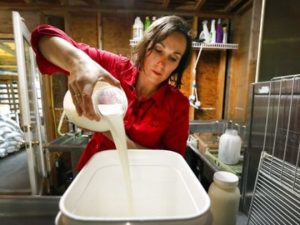Kellogg’s really sucks at the food safety thing.
After a bunch of their products were recalled in the Peanut Corporation of America (PCA) shitfest of 2008-09, their president testified to Congress that they relied on third-party audits and wanted government to increase inspections.
 Ha.
Ha.
The U.S. Centers for Disease Control (CDC), public health and regulatory officials in several states, and the U.S. Food and Drug Administration are investigating a multistate outbreak of Salmonella Mbandaka infections.
There have been 73 ill people reported from 31 states, including 24 people who have been hospitalized. No deaths have been reported.
Illnesses started on dates ranging from March 3, 2018 to May 28, 2018.
On June 14, 2018, the Kellogg Company recalled 15.3 oz. and 23 oz. packages of Kellogg’s Honey Smacks cereal. Recalled Kellogg’s Honey Smacks cereal has a “best if used by” date from June 14, 2018 through June 14, 2019. The “best if used by” date is on the box top.
Consumers should not eat and retailers should not serve or sell recalled Kellogg’s Honey Smacks cereal.
If you have recalled Kellogg’s Honey Smacks cereal:
Throw out the cereal or return it for a refund.
If you store cereal in a container without the packaging and don’t remember the brand or type, throw it away.
Thoroughly wash the container with warm, soapy water before using it again to remove harmful germs that could contaminate other food.
Kellogg says it launched an investigation with the third-party manufacturer who produces Honey Smacks immediately after being contacted by the Food & Drug Administration (FDA) and Centers for Disease Control (CDC) regarding reported illnesses.
Our own Benji told Rachael Rettner of Live Science “A dry heat actually makes [Salmonella] more persistent in a food or ingredient,” Benjamin Chapman, an associate professor and food safety specialist at North Carolina State University, told Live Science in a February 2018 interview.
Outbreaks of Salmonella tied to cereal have happened before. In 1998, the CDC reported an outbreak of more than 200 cases of Salmonella tied to Millville brand plain Toasted Oats cereal. Salmonella bacteria are relatively resistant to drying processes, and can survive for long periods in dry environments such as cereal, the CDC said at the time.
Indeed, 10 years after the 1998 outbreak, CDC officials reported another Salmonella outbreak tied to the same cereal company. In that case, the officials hypothesized that a construction project within the manufacturing facility, which involved removal of a wall, may have allowed the reintroduction of the dried outbreak strain of Salmonella into the cereal production area.
That “outbreak highlight[ed] the resilience of Salmonella, suggesting that this organism can persist in dry food production environments for years,” the researchers concluded in a 2008 report.
When anyone from Kellogg’s talks about food safety, have a chuckle and move on; or tell them what dickshits they are and how they know nothing about food safety.
And take responsibility for products you put your name on.
Unless you strive to be the Donald Trump of food production.
Audits and inspections are never enough: A critique to enhance food safety
30.aug.12
Food Control
D.A. Powell, S. Erdozain, C. Dodd, R. Costa, K. Morley, B.J. Chapman
http://www.sciencedirect.com/science/article/pii/S0956713512004409?v=s5
Abstract
Internal and external food safety audits are conducted to assess the safety and quality of food including on-farm production, manufacturing practices, sanitation, and hygiene. Some auditors are direct stakeholders that are employed by food establishments to conduct internal audits, while other auditors may represent the interests of a second-party purchaser or a third-party auditing agency. Some buyers conduct their own audits or additional testing, while some buyers trust the results of third-party audits or inspections. Third-party auditors, however, use various food safety audit standards and most do not have a vested interest in the products being sold. Audits are conducted under a proprietary standard, while food safety inspections are generally conducted within a legal framework. There have been many foodborne illness outbreaks linked to food processors that have passed third-party audits and inspections, raising questions about the utility of both. Supporters argue third-party audits are a way to ensure food safety in an era of dwindling economic resources. Critics contend that while external audits and inspections can be a valuable tool to help ensure safe food, such activities represent only a snapshot in time. This paper identifies limitations of food safety inspections and audits and provides recommendations for strengthening the system, based on developing a strong food safety culture, including risk-based verification steps, throughout the food safety system.
 Authorities said they suspect both are foodborne but do not yet know the source.
Authorities said they suspect both are foodborne but do not yet know the source.









